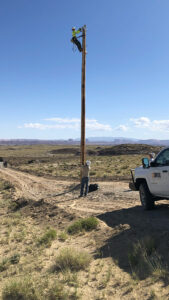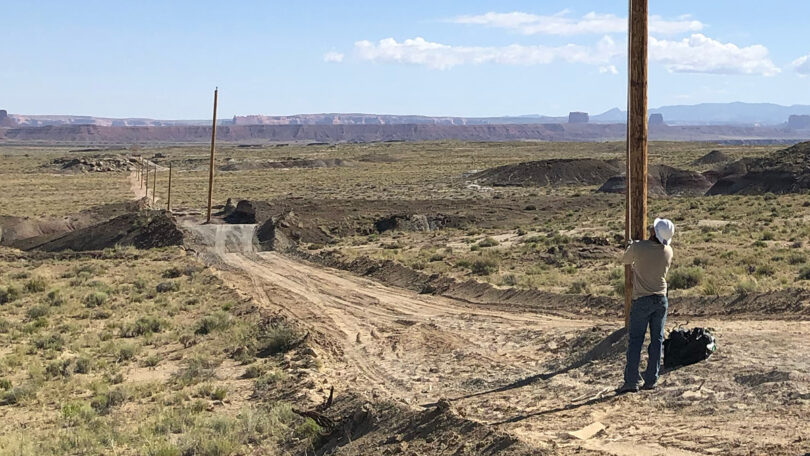Concern for Community reaches beyond Colorado
By Kent Singer, CREA Executive Director
In previous columns, I have written about CREA’s efforts to send Colorado electric co-op lineworkers to rural Guatemala to bring electric service to remote villages. Working with our partners at the Oklahoma Association of Electric Cooperatives and NRECA International, we have sponsored three trips to Guatemala that resulted in the “electrification” of hundreds of homes, schools, and churches in one of the poorest regions of Central America. We’re sponsoring another trip this summer to send two co-op employees back to Guatemala to help complete the inside wiring of more homes.
We believe strongly in the international program and all the benefits that it brings to people without electric service outside the United States. Recently, however, we learned about a similar need that exists much closer to home in the Navajo Nation that spans parts of northeastern Arizona, northwestern New Mexico, and southeastern Utah. While most citizens of the reservation have electric service, there are still approximately 13,000 Navajo households that do not have electricity.
To remedy this situation, the American Public Power Association and the Navajo Tribal Utility Authority launched the “Light Up Navajo” initiative in 2019. The objective of the project is to provide electric service to Navajo families who currently live without electricity. Many municipal utilities and electric co-ops are working with NTUA to extend power lines to people who want the service.
One of the electric co-ops that sent crews to work on the project is Montrose-based Delta-Montrose Electric Association, a member of CREA. I was recently invited to observe and (to a very limited extent) participate in Light Up Navajo IV and I came away from the experience with a couple of main thoughts.
First, it’s hard to conceive that in the year 2023 there are thousands of people in any community in the United States who don’t have access to electricity. As electric co-ops, we pride ourselves on our eight-decade history of bringing electricity to rural America knowing that service would not have been provided by investor-owned utilities. That was the primary goal of the REA program when it was initiated in 1936: to bring light to America’s farms and ranches just as it was provided in the cities.

A DMEA crew works to wire poles for Light Up Navajo.
But it’s clear to me that while the electric co-op program was and is a huge success, a dire need still exists on Native American reservations such as the Navajo Nation. To the extent we can help serve this need, we can and should meet that call.
Second, I will never cease to be amazed by the skill and dedication of Colorado’s electric lineworkers. When I arrived at the job site just north of the town of Many Farms on the Navajo Nation reservation, I got there just in time to meet the convoy of trucks and heavy equipment. It was about 2:30 p.m. on a Sunday afternoon and I assumed that the crew would drop off the poles and other equipment for the job and then get started Monday morning.
What a ridiculous assumption!
The DMEA team, working with a municipal utility crew from Utah, immediately began unloading the twelve 40-foot cedar utility poles from two trailers and laying them down at the appropriate intervals to cover the mile-long stretch of line that was to be built. Over the next eight hours, working well after the sun set (and with the aid of lights on the truck), the crew used a digger derrick to dig the holes, set and true up the poles, tamp and backfill the holes, and do everything else needed to prepare the poles for wiring the next day. When all 12 poles were installed, they were so straight that if you stood behind a pole at one end of the project site, you couldn’t see any of the other 11 poles!
On day two, the crew came back to the job site and, in a few short hours, installed all the wires that would connect the power line to the grid at one end, and to the home that would receive the new service on the other end. It was a thing of beauty to watch the DMEA crew orchestrate the unspooling of both the ground wire and the phase that would become energized and install both of those wires, nearly a mile in length.
Colorado’s electric co-ops exist to improve the lives of our members and to enhance our co-op communities. We operate and serve under the co-op principle of Concern for Community and that service extends beyond our co-op communities. We will continue to find opportunities to serve others both outside the United States and closer to home.
Kent Singer is the executive director of CREA and offers a statewide perspective on issues affecting electric cooperatives. CREA is the trade association for 21 Colorado electric distribution co-ops and one power supply co-op.

